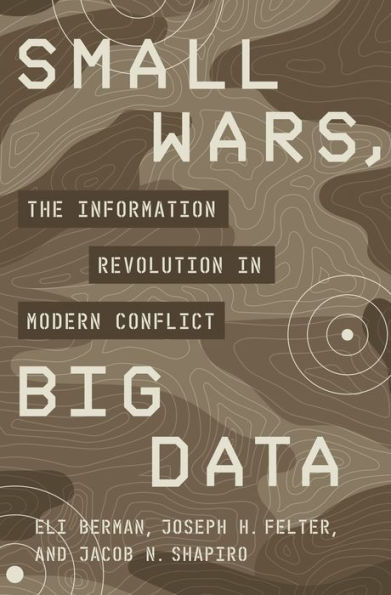
Small Wars, Big Data: The Information Revolution in Modern Conflict
408
Small Wars, Big Data: The Information Revolution in Modern Conflict
408Hardcover
-
PICK UP IN STORECheck Availability at Nearby Stores
Available within 2 business hours
Related collections and offers
Overview
The way wars are fought has changed starkly over the past sixty years. International military campaigns used to play out between large armies at central fronts. Today's conflicts find major powers facing rebel insurgencies that deploy elusive methods, from improvised explosives to terrorist attacks. Small Wars, Big Data presents a transformative understanding of these contemporary confrontations and how they should be fought. The authors show that a revolution in the study of conflict—enabled by vast data, rich qualitative evidence, and modern methods—yields new insights into terrorism, civil wars, and foreign interventions. Modern warfare is not about struggles over territory but over people; civilians—and the information they might choose to provide—can turn the tide at critical junctures.
The authors draw practical lessons from the past two decades of conflict in locations ranging from Latin America and the Middle East to Central and Southeast Asia. Building an information-centric understanding of insurgencies, the authors examine the relationships between rebels, the government, and civilians. This approach serves as a springboard for exploring other aspects of modern conflict, including the suppression of rebel activity, the role of mobile communications networks, the links between aid and violence, and why conventional military methods might provide short-term success but undermine lasting peace. Ultimately the authors show how the stronger side can almost always win the villages, but why that does not guarantee winning the war.
Small Wars, Big Data provides groundbreaking perspectives for how small wars can be better strategized and favorably won to the benefit of the local population.

Product Details
| ISBN-13: | 9780691177076 |
|---|---|
| Publisher: | Princeton University Press |
| Publication date: | 06/12/2018 |
| Pages: | 408 |
| Product dimensions: | 6.00(w) x 9.20(h) x 1.40(d) |
About the Author
Read an Excerpt
CHAPTER 1
KNOW THE WAR YOU'RE IN
The first, the supreme, the most far-reaching act of judgment that the statesman and commander have to make is to establish the kind of war on which they are embarking.
— Carl von Clausewitz
It seems unfathomable now, but by directive, at that time we weren't even allowed to use the term "insurgency" or "insurgents," even though everyone knew that's what we were facing every day. ... It was very frustrating for soldiers operating in these conditions because they rarely saw the enemy but were constantly reacting to the variety of methods they employed to attack them. This was the reality we were settling into after a month or so on the ground.
— Colonel Brynt Parmeter, USA, Retired, on soldiers trained for a big conventional war finding themselves facing an asymmetric one, in Iraq in 2004
0630 hrs 6 June 2004, Tikrit, Iraq
Major General Batiste, commanding general of the U.S. Army 1st Infantry Division, looked with some anticipation into the faces of the thirty-odd staff officers and NCOs filing in for the daily division operations update. Fatigue and stress had etched lines onto nearly all, though most were still young. Those nearing the end of a night shift supporting the division's maneuver elements conducting neighborhood sweeps, manning checkpoints, and other operations could be readily distinguished from those just beginning their day by their weary expressions or by the day's growth of beard on their chins.
The room was incongruously grand. Marble floors reflected the light from a crystal chandelier at the center, while Moorish arches opened onto darkened hallways at the periphery. The 1st Division staff occupied the palace where Saddam Hussein and his entourage used to stay when visiting his hometown of Tikrit — one of many such compounds across Iraq. One adaptation the soldiers had made was to erect crude, stadium-style seating in front of a podium and three large screens. The smell of fresh-cut plywood still permeated the room. The 1st Division members took their seats, many clutching the ubiquitous plastic water bottles with dust-coated hands. Before them hung blank white screens, and next to them maps of the town — a grid of streets with the dark braid of the Tigris River running from north to south. Operational graphics representing the disposition and location of friendly forces, unit boundaries, and other icons were neatly transcribed in fine-tipped Sharpie onto acetate sheets overlaying the maps.
The troops expected the operations update to refer to this geography, but when a map was projected on the screen, it showed the gentle curve where the English Channel meets the coast of France. This operations update was special: today was 6 June 2004, and the division staff had used computeraided graphics and satellite imagery to develop an operations update reflecting the 1st Infantry Division's participation in the Allied landings in Normandy exactly sixty years earlier.
0630 hrs 6 June 1944
Machine-gun fire ripped across the deck the moment the ramp dropped from the Higgins amphibious assault vehicle. Bullets wounded or killed many of the lead elements of the U.S. Army 1st Infantry Division's invasion force before their boots touched the sand.
Soon Omaha Beach was soaked in blood. German artillery fire rained down on the advancing forces. The soldiers who made it past submerged obstacles and through this gauntlet of fire to reach the crescent-shaped beach had to traverse an additional three hundred meters of fire-swept open ground laced with barbed wire and studded with land mines. Only then did they reach the first available cover at the base of the bluffs.
A number of the soldiers storming the beach on that historic morning were seasoned veterans of multiple campaigns. The 1st Infantry Division had initially seen combat in North Africa in 1942, then fought in the invasion of Italy in 1943. Given the extraordinary operations tempo the division had maintained and the major battles and campaigns it participated in early in the war, many believed it would be spared assignment to the first wave of Operation Overlord's invasion force. But the senior leaders developing the invasion plans decided to send this seasoned division in with the initial assault on Normandy. The soldiers were not expecting to land unopposed, but still they were shocked to meet with seemingly impenetrable resistance from German defenders securely dug in and well prepared, including the only full-strength enemy infantry division in France.
The first day, Allied forces suffered approximately ten thousand killed, wounded, or missing in action, and German forces approximately nine thousand, despite their well-prepared and fortified positions. In total, nearly half a million combatants would eventually be killed or wounded in the Normandy campaign. The Allied forces who survived the bloody amphibious assault, secured the beachhead, and made their way inland faced the extraordinary challenge of advancing across occupied France and into the German homeland. Missions of the storied 1st Infantry Division would include employing fire, maneuver, and shock effect to destroy German forces in the field, seize cities and key terrain from German control, and destroy industrial bases and other means of resistance.
The ultimate goal of the 1st Division was to secure the unconditional surrender of Hitler's regime — clearly defined, though by no means easy to achieve. Success on the battlefield was a necessary and nearly sufficient condition to achieve ultimate victory over the Axis Powers.
In this war, state capacity was readily translated into success on the battlefield. Allied forces would eventually prevail because the industrial base of the United States, once mobilized by the fully supportive political leadership and committed American public, enabled them to produce the massive amount of war matériel required to turn the tide. Bombing raids over Germany increased and Allied infantry forces progressed rapidly across France and into Germany itself. In April 1945, less than ten months after the assault on the Normandy coast, U.S. and British forces linked up with the Soviet Red Army and secured Germany's unconditional surrender.
Major General Batiste turned off the projections and raised the lights. He brought the formal ceremony to its culmination: "Commanders, present your soldiers the shoulder sleeve insignia of the 1st Infantry Division on this day, sixty years after our forefathers landed on the beaches of Normandy."
All of the 1st Infantry Division members now carried the striking image of the division's "Big Red 1" insignia on both shoulders, the left and now the right. In the U.S. Army, soldiers wear the patch of the current unit on their left shoulder. By tradition, they wear the insignia of units they have served with in combat on their right and are authorized to wear them there for the rest of their time in service. Save for a handful of senior noncommissioned officers and officers who had served in Desert Storm or in the Panama invasion over a decade earlier, this was the first time the division's soldiers earned this privilege and distinction.
Major General Batiste recited the 1st Infantry Division's World War I motto: No mission too difficult, no sacrifice too great, duty first.
This story was told to us by Colonel Brynt Parmeter, USA, Retired. At the time, he was Chief of Operations ("CHOPS") in charge of a critical section of the 1st Infantry Division operation staff responsible for the current and near-term operations of the division. Among his many duties were morning updates and evening radio net calls, to ensure a common understanding of current and future activities among commanders and staff.
Prior to deployment, the 1st Division had trained in much the same way that U.S. Army units based in Germany had done throughout the Cold War, maneuvering combat units to engage and destroy a conventional enemy. A number of the division's members were veterans of the first Gulf War. Ground fighting there had lasted just ninety-six hours and resulted in an overwhelming victory for the U.S. and Coalition forces over the Iraqi military. This had seemed a validation of the U.S. military's approach to defeating its foes through technological dominance of the battlefield from air, sea, and land. Aside from the recent peacekeeping missions in Bosnia and Kosovo, the unit had little experience with insurgency.
Unfortunately, neither the train-up nor the experience in the first Gulf War did much to prepare the 1st Division's leaders and soldiers for what they found in Iraq: roadside bombs, assassinations of village leaders friendly to the Coalition, and the destruction of bridges and other infrastructure. "Vehicle-borne explosives starting to pop up," Parmeter explained, "and you had small arms fire attacks just randomly through urban areas and land mines placed to hit our forces."
Though the 1st was suffering nowhere near the casualties seen on D-Day or throughout World War II, it was not uncommon to experience more than fifty enemy attacks a day across the division's area of operations, and there were casualties every day. These were not clustered around any front — attacks could happen at any moment, anywhere U.S. forces were deployed across the increasingly restive country.
Major General Batiste's purpose in reminding his soldiers of the 1st Division's powerful history at Normandy was to give them an additional source of support and stability to draw on during those challenging times. But his reminder also highlighted what a different tactical challenge the division faced and how, in essence, they were better prepared for battles like Normandy than for Tikrit. In Iraq, the 1st Division soldiers had a steep advantage over the enemy — unprecedented firepower, vehicles, and technology — but they rarely had the opportunity to use these against the elusive and seemingly invisible insurgents. Even the most advanced surveillance systems had a difficult time confirming whether an individual was the enemy and whether the people surrounding him were combatants or civilians.
Fortunately, Major General Batiste and most of the senior leaders quickly recognized that this fight was unlike the first Gulf War and more like the "small" subnational wars in Bosnia and Kosovo, where the U.S. military had played a peacekeeping role. Both the 2nd and 3rd Brigades had spent time in Kosovo, where they had encountered a similar, though much less violent, insurgency. Batiste knew that the 1st Division needed to conduct precision actions: raids and other operations to find and capture or kill the insurgent groups and individuals responsible for the violence. To do this, they first had to learn to engage with the local population, gain their trust, glean fragments of information from them, and piece these together into a coherent intelligence estimate. Each step in this process represented a major challenge.
About a month after the D-Day commemoration, an insurgent dressed in police uniform detonated a car bomb at a building occupied by 1st Division soldiers and Iraqi policemen, killing many of both in Samarra, a city forty miles from Tikrit. This marked the beginning of a period of intense insurgent activity: every patrol entering Samarra met some combination of small arms fire, rocket-propelled grenades, improvised explosive devices, and indirect fire. Later in the summer, the 1st Division and other units pushed into the city and drove out most of the insurgents. Afterward, 1st Battalion, 26th Infantry stayed to conduct "hold-and-build operations" while the other units withdrew. Parmeter described the variety of activities this entailed:
On one day, patrolmen would go out and meet with a group of primary school teachers to figure out how we could set up an education program in a town. On the next patrol two hours later, we would try to set up a terrain-denial patrol around a known mortar-firing location. Two hours after that we would go and meet with the mayor and his city infrastructure team (which may or may not even have existed) to try to figure out how we could fix an electrical problem or water problem in the town. And then our last patrol would be to go to secure a police recruiting drive to protect the individuals that might want to sign up to attend a training academy — which we had to set up — to be future policemen. All of this was part of Major General Batiste's directive to conduct intelligence-driven operations and protect the population from the insurgents. This made the population more likely to provide information on bad actors when they had it, which helped us interdict planned attacks and successfully target insurgents.
The months that followed the initiation of combat operations in Samarra were trying, with numerous attacks suffered, and a strong effort by the insurgents to push Coalition forces out. Parmeter described their strategy:
It was during this stage that every one of the U.S. soldiers in Samarra realized that we gained very little through violence in the form of kinetic responses. They were often the worst response especially in urban and other areas with a high risk of collateral damage. In fact, we suspected that for every Iraqi killed or injured by U.S. forces, we were essentially creating more new insurgents. On the contrary, for every non-kinetic action where we were assisting the population, like helping with the hospitals, schools, critical infrastructure, and other similar activities, we were taking the power away from the insurgents and encouraging greater support and collaboration from among the population.
According to Parmeter, the 1st Infantry Division realized that they were in a war fought for the support and cooperation of the local population — a population who could provide information — completely different from the war their forefathers waged in 1944 and 1945 or that they themselves had fought in Kuwait and Iraq in 1991. It would be two years before Lieutenant General David Petraeus and Major General James Mattis would compile the lessons Parmeter and his fellow soldiers were learning into FM 3-24 — the U.S. Army-Marine Corps counterinsurgency manual — the first resource of its kind since the Vietnam War era.
TWO TYPES OF WAR
One legendary division, two very different wars. There are innumerable technological and political differences from one conflict to another sixty years later. However, when it comes to theories of war and paths to victory, many of the starkest differences between those wars come down to one important dichotomy: symmetric versus asymmetric.
Symmetric wars include international contests such as the two world wars. The victor is generally the side with superior weapons and larger armies. They also include civil (or "subnational") wars where protagonists of roughly equal capacity fight primarily over territorial control. In the later stages of the Vietnam War, for instance, combatants from North and South Vietnam fought along well-defined fronts as in international wars, with victory secured by a combination of superior weaponry, numbers, and strategy. Civilians matter in these conflicts, of course, but mostly because they provide soldiers and resources to the battlefield.
Asymmetric wars, by contrast, are contests where one side enjoys a heavy matériel and capabilities advantage. These include the post-9/11 U.S. engagements in Iraq and Afghanistan, as well as numerous historical examples. In Napoleon's struggle to control the Iberian Peninsula, he didn't face one central opponent but instead fought many "little wars," the origin of the term "guerrilla." Nearly a century later, after Spain ceded the Philippines to American control, the United States waged a three-year war within this newly acquired territory against multiple semi-independent insurgent groups. It ended officially in victory in 1902 but saw sporadic violence for years afterward. On the Eastern Front in World War II, Hitler's army struggled to root out insurgencies, notably the Yugoslav Partisans and Polish Underground State, but also the Ukrainian Insurgent Army, who would go on to fight the Soviet Union until 1949, long after that war had slipped from public view.
In symmetric wars, the struggle is primarily over territory. Information plays an important role, to be sure, but it is not decisive in the same way. Both the D-Day landing in Normandy and the 1991 U.S. invasion of Kuwait involved deception campaigns designed to make the enemy think the main attack would be in a different location than it was. But the value of a given piece of information in symmetric conflicts can vary greatly. Knowing who the opposing commander is or where he is, for example, is of little value if he is in a well-protected bunker too far behind enemy lines to be targeted with available means.
(Continues…)
Excerpted from "Small Wars, Big Data"
by .
Copyright © 2018 Princeton University Press.
Excerpted by permission of PRINCETON UNIVERSITY PRESS.
All rights reserved. No part of this excerpt may be reproduced or reprinted without permission in writing from the publisher.
Excerpts are provided by Dial-A-Book Inc. solely for the personal use of visitors to this web site.
Table of Contents
Preface ix
1 Know the War You're In 1
2 Esoc's Motivation and Approach 23
3 Information-Centric Insurgency and Counterinsurgency 55
4 The Information Mechanism 82
5 The Role of Development Assistance 109
6 The Role of Suppression 152
7 How Civilians Respond to Harm 184
8 Economic Conditions and Insurgent Violence 223
9 What Works? Leveraging the Information Mechanism 262
10 The Enduring Importance of Understanding Asymmetric Conflict 291
Notes 329
Index 377
What People are Saying About This
"The soldier-scholar authors, who served in the wars they describe, have produced a book that should be required reading for military leaders, policymakers, development professionals, and diplomats."—Retired U.S. Army General David H. Petraeus"This well-written book will greatly interest all those working in war zones and those who study warfare."—Peter Bergen, author of United States of Jihad"Small Wars, Big Data heralds a revolution in conflict studies."—Anne-Marie Slaughter, president and CEO of New America"This book makes a stimulating and challenging contribution to understanding the role of social science in the conduct of modern war."—Lawrence Freedman, author of The Future of War
Related Subjects
Videos




